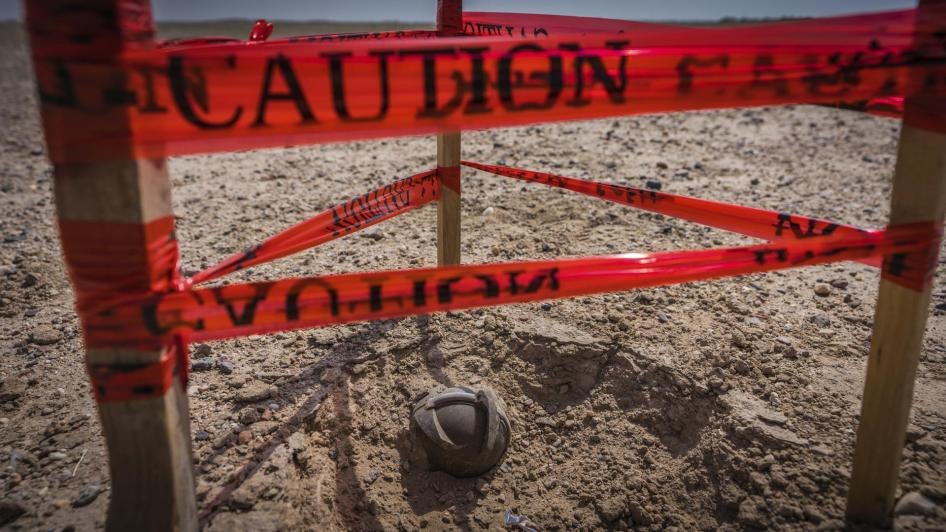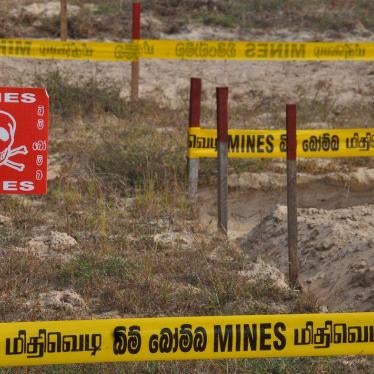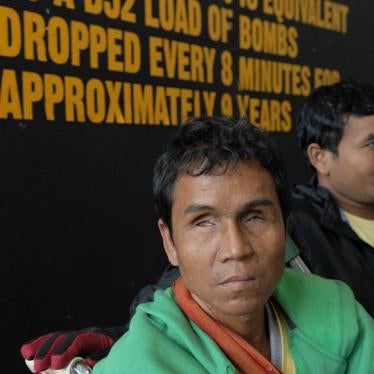In the US, a November 30, 2017 Defense Department policy directive abandons a longstanding policy requiring the US not use cluster munitions that result in more than a 1 percent unexploded ordnance after 2018. Human Rights Watch has condemned the policy for halting a long-planned move away from inaccurate cluster munitions. The US claims that cluster munitions have military utility, but last used them during the 2003 invasion of Iraq, with the exception of a single 2009 attack in Yemen. There is no evidence that the US or its coalition partners have used cluster munitions against the Islamic State (also known as ISIS) in Syria and Iraq.
Cluster munitions can be fired from the ground by artillery systems, rockets, and projectiles, or dropped from aircraft. They typically open in the air, dispersing multiple bomblets or submunitions over a wide area. Many submunitions fail to explode on initial impact, leaving dangerous duds that can maim and kill like landmines for years.
Currently, there are 103 states parties to the Convention on Cluster Munitions, while 17 countries have signed, but not yet ratified. There has been no new use, production, or transfers of cluster munitions by any state party since the convention was adopted on May 30, 2008. All states parties facing the first eight-year stockpile destruction deadline – August 1, 2018 – successfully destroyed their stocks in time, including Croatia, Slovenia, and Spain in the past year. Cuba, a new state party, also completed its stockpile destruction, while Switzerland is expected to announce completion imminently.
The destruction to date of a collective total of 1.4 million cluster munitions and more than 177 million submunitions means that 99 percent of the total reported global stocks held by states parties have now been destroyed. During 2017, seven countries destroyed a total of 33,551 cluster munitions and 1.7 million submunitions.
However, use of cluster munition by Syrian government forces on anti-government-held areas of the country, which began in 2012, continued throughout 2017 and the first half of 2018. The number of recorded cluster munition attacks fell over the past year, in part due to the decreasing number of areas that remain outside of the government’s control. In Yemen, far fewer cluster munition attacks were reported over the last year by a Saudi-led coalition that has conducted a military operation against Houthi forces in Yemen since March 2015. That decrease comes after strong public outcry, global media coverage, and widespread condemnation. There is evidence that cluster munitions may have been used in Egypt and Libya, but it has not been possible to independently confirm these allegations. None of these countries are party to the Convention on Cluster Munitions.
According to the Cluster Munition Monitor, there were 289 new casualties in 2017 and 99 percent of cases in which the victim’s status was reported were civilians. That included 187 casualties in Syria and 54 in Yemen from both new attacks and explosive remnants. There were 32 new casualties in Laos, all from unexploded submunitions used by the US in the 1960s and 1970s. The number of new victims in 2017 is a sharp decrease from the 971 reported in 2016, but many casualties go unrecorded or lack sufficient documentation.
Since the publication of last year’s report, Sri Lanka was the only country to ratify or accede to the convention, on March 1.
For the third consecutive year, Russia voted with Zimbabwe in December 2017 against a United Nations General Assembly resolution promoting the convention, though 32 non-signatories voted for the resolution. Russia has participated in a joint military operation with Syrian forces since September 30, 2015, in which cluster munitions have caused extensive civilian harm.
According to the Cluster Munition Monitor, 26 countries, including 12 states parties and two signatories, are contaminated by cluster munition remnants. Around the world, at least 153,000 submunitions were destroyed during 2017 in clearance operations. Under the convention, eight states parties have completed clearance of their contaminated land.
Most states parties have formally declared they are not retaining any cluster munitions for training or research, as the treaty permits, though 12 treaty members are. Thirty have enacted national laws to carry out the convention, and another 20 are in the process of doing so.
“Several states parties still have significant work to do to clear contaminated areas, assist victims, report on their implementation, and ensure they have laws and other measures to punish any violations,” Wareham said. “Countries needing assistance should not hesitate to request help, as cooperative compliance is the bedrock of this treaty.”
Cluster Munition Monitor 2018 will be presented at the Eighth Meeting of States Parties to the Convention on Cluster Munitions, which opens at the United Nations in Geneva on September 3.









